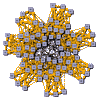
SAT-Race
2006
Qualification
There will be two qualification rounds for registered solvers, where successful participation in at least one of them is mandatory to be accredited for SAT-Race.
In each round, we check the following requirements:
Requirements
- Conformance to I/O specification. Solvers have to respect the I/O requirements. In particular, the output must contain a solution line (starting with "s ") and—in case of a satisfiable instance—at least one values line (starting with "v "). Exit codes also must be set correctly (10 for satisfiable, 20 for unsatisfiable, 0 for unknown).
- Correctness of results. The solvers are not allowed to produce wrong answers (e.g. 'satisfiable' for an unsatisfiable instance, but of course they may time-out).
- Sufficient performance. Solvers must meet some minimal speed requirements. We will set the level of required performance particularly high for the first qualification round to stimulate improvement of solvers.
Cheating (e.g. pre-computing results) is not allowed. We will check all solvers on additional instances, and fraudulent solvers will be disqualified (the organizing committee will decide on this).
Dates
The dead-lines for the qualification rounds are May 17 for the first one, and June 16 for the second one.
First Qualification Round
The first qualification round has taken place on and after May 17. Each solver had to tackle all 50 instances of the first benchmark test set. In contrast to the SAT-Race itself, the run-time limit was set to 20 minutes per solver and instance. Solvers which were able to solve at least 40 instances are already qualified for SAT-Race 2006. These solvers are:
| Solver | Submitter | Affiliation | #Solved |
|---|---|---|---|
| Eureka | Alexander Nadel | Intel | 45 |
| Rsat | Thammanit Pipatsrisawat | UCLA | 45 |
| Bsat (BarcelogicTools) | Robert Nieuwenhuis | Technical University Catalonia, Barcelona | 43 |
| Actin (minisat+i) | Raihan Kibria | TU Darmstadt | 43 |
| Tinisat | Jinbo Huang | National ICT Australia | 41 |
| zChaff | Zhaohui Fu | Princeton University | 41 |
Second Qualification Round
The second qualification has taken place on and after June 16. Each solver had to tackle all 50 instances of the second benchmark test set. In contrast to the SAT-Race itself, the run-time limit was set to 20 minutes per solver and instance. Solvers that participated successfully—and thus are qualified for SAT-Race 2006—are:
| Solver | Submitter | Affiliation | #Solved | Score |
|---|---|---|---|---|
| Actin (minisat+i) | Raihan Kibria | TU Darmstadt | 39 | 46.91 |
| MiniSAT 2.0 beta | Niklas Sörensson | Chalmers University, Gothenburg | 39 | 46.63 |
| picosat | Armin Biere | JKU Linz | 38 | 43.92 |
| Cadence MiniSAT | Niklas Eén | Cadence | 36 | 42.61 |
| Rsat | Thammanit Pipatsrisawat | UCLA | 35 | 41.25 |
| qpicosat | Armin Biere | JKU Linz | 34 | 40.24 |
| Tinisat | Jinbo Huang | National ICT Australia | 34 | 40.20 |
| sat4j | Daniel Le Berre | CRIL-CNRS | 30 | 34.60 |
| qcompsat | Armin Biere | JKU Linz | 29 | 33.84 |
| compsat15 | Armin Biere | JKU Linz | 26 | 30.71 |
| mxc | David Mitchell | Simon Fraser University | 23 | 26.76 |
| mucsat | Nicolas Rachinsky | LMU Munich | 20 | 22.91 |
| Hsat | Domagoj Babic | University of British Columbia | 20 | 22.51 |
The scores have been calculated using the scoring scheme described on the Rules page. These 13 solvers, besides the three solvers that already qualified in the first round and did not participate in the second, are now qualified for SAT-Race 2006.